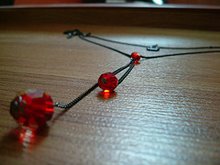









Ruby is a red gemstone. Rubies can vary from a light pink to a blood red, a variety of the mineral corundum (aluminium oxide). The color is caused mainly by chromium. Its name comes from ruber, Latin for red. Natural rubies are exceptionally rare, but synthetic rubies (sometimes called created ruby) can be manufactured fairly cheaply. Other varieties of gem-quality corundum are called sapphires. It is considered one of the four precious gems, together with the sapphire, the emerald and the diamond.
Rubies are mined in Africa, Asia, Australia, Greenland, Madagascar and North Carolina. They are most often found in Myanmar (Burma), Sri Lanka, Kenya, Madagascar, and Cambodia, but they have also been found in the U.S. states of Montana, North Carolina and South Carolina. The Mogok Valley in Upper Myanmar has produced some of the finest rubies but, in recent years, very few good rubies have been found there. The unique color in Myanmar (Burmese) rubies is described as "pigeon’s blood". They are known in the trade as “Mogok” rubies. In central Myanmar the area of Mong Hsu also produces rubies. The latest ruby deposit to be found in Myanmar is situated in Nam Ya. In 2002 rubies were found in the Waseges River area of Kenya. Sometimes spinels are found along with rubies in the same rocks and are mistaken for rubies. However, fine red spinels may approach the average ruby in value.
Rubies have a hardness of 9.0 on the Mohs scale of mineral hardness. Among the natural gems only diamond is harderRuby gemstones are valued according to size, color, clarity and cut. All natural rubies have imperfections in them, including color impurities and inclusions of rutile needles known as "silk". Gemologists use these needle inclusions found in natural rubies to distinguish them from synthetics, simulants, or substitutes. If there is no silk in the stone, that shows that the stone was heated to a temperature of up to 1800°C (3272ºF) in an oven to give the ruby a better color of red. Usually the rough stone is heated before cutting. About 90% of all rubies today are heated, and rubies which are not heated are considered unusual. Some rubies undergo a process of low tube heat, when the stone is heated over charcoal of a temperature of about 1300ºC (2372ºF) for 20 to 30 minutes. The silk is partially broken and the color is improved. The fracture filling of rubies is also done intentionally, and it is not always disclosed to gem buyers. Glass-filling voids in rubies, without disclosure, is considered an unethical practice.
Ref. Wikipedia




No comments:
Post a Comment